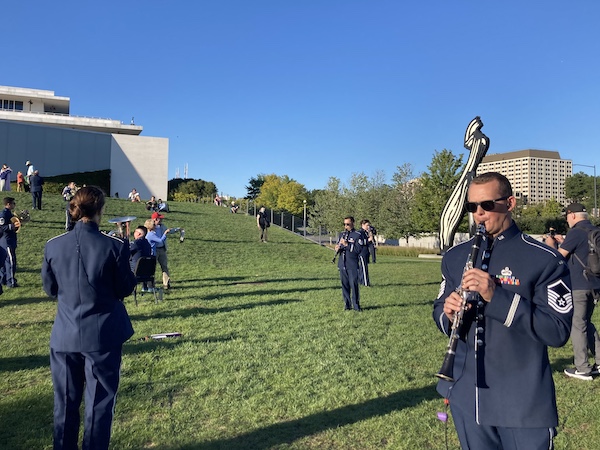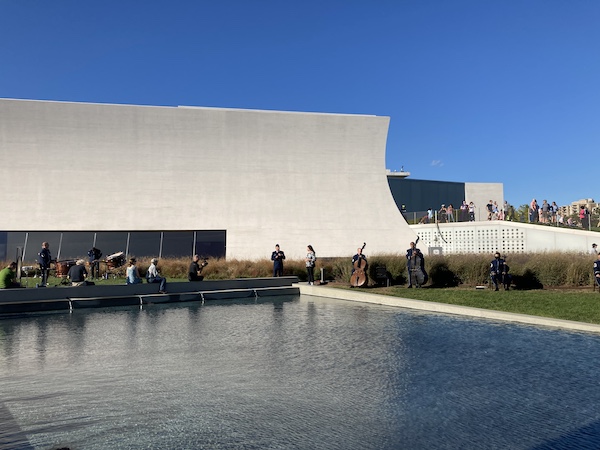John Luther Adams’ “Sila” breathes new life into Kennedy Center’s REACH

The U.S. Air Force Band performed John Luther Adams’ Sila at the Kennedy Center’s REACH on Sunday. Photo: Olivia Hampton
As the shimmering afternoon sun cast shadows across the Kennedy Center’s riverside REACH gardens, a faint rumble of bass drums grew louder like an organic extension of the traffic below and the planes overhead. Clusters of string, woodwind and brass players spread across the lawn and hillside then joined in with slowly rising arpeggios, accompanied by the singers who pressed analog megaphones to their mouths.
It was a homecoming of sorts. Performed by the U.S. Air Force Band and presented by Washington Performing Arts, John Luther Adams’s Sila: The Breath of the World returned Sunday to Washington following a local debut at Constitution Gardens by the National Mall in 2015, one year after its Lincoln Center premiere.
Co-commissioned by Washington Performing Arts, the hour-long piece is designed for five flexible ensembles of 16 to 80 musicians performing individually, successively or simultaneously in various combinations of winds, brass, voices, percussion and strings. Each grouping performs a series of 16 precisely timed harmonic clouds or sound masses, evolving from B-flat overtones shaped into long, gradually shifting phrases. There is no conductor and each musician can pace each tone or phrase as long as it lasts “one full exhalation,” as directed in the score. “Follow the breath,” the composer demands.
On Sunday, listeners wandered among the musicians and the lush landscaping to hone in on individual voices or experience the interwoven nature of the various parts. Each performance is unique depending on the individual performers, audience members and the setting—and how they interact with one another.
Such aleatoric components are critical to Adams, the 2014 Pulitzer Prize winner whose music is inspired by the complex relationships and interconnectedness of humans with nature.
That unity with the environment is at the heart of the nondenominational mysticism that imbues Adams’ work. Sila may as well have been a consecration of the REACH, which has struggled to define its purpose ever since the 4.6-acre space—dotted with light-filled halls, studios and galleries— opened to the public in September 2019, six months before the spate of pandemic closures.
The word Sila derives from the traditions of the Inuit peoples who live in Arctic regions including Alaska, which Adams called home for much of his adult life. In the composer’s translation of the title of the piece, “Sila is the wind and the weather, the forces of nature. But it’s also something more. Sila is intelligence. It’s consciousness. It’s our awareness of the world around us, and the world’s awareness of us.”

Photo: Olivia Hampton
Unlike the New York premiere, no performers waded in the reflecting pool or moved to Mark DeChiazza’s choreography. Here, members of the uniformed Air Force Band sat, stood or walked slowly, lending a more solemn, ceremonial tone to the performance, which still managed to remain organic and intimate.
The 49 musicians were carefully attuned to one another and everything around them, embodying the impeccable texture and pacing for which Adams is known. Without a stage, the traditional divide between performer and viewer dissipated. Viewers ventured within steps of the musicians, snapping photographs or tripping on the wires that connected them to four audio technicians who directed them from under a tent toward new transitions in the piece.
At times, the rising phrases cut through the hum of traffic along the busy north bank, but often they simply melded into a complex soundscape that also included bird song, a mother calling loudly after her child, the scraping of chairs on the ground and chatter among the public. The natural and artificial surroundings participated in the shifting construct that makes up the piece.
As the piece drew to a close, the singers embodied this breath of life by exhaling audibly through their megaphones for about three minutes. String players bowed lightly across their strings and percussionists used bows on the sides of their cymbals and a large gong. Gradually, they breathed into silence while crickets chirped louder and louder—unless it was the performance that made the insects’ presence more discernible than ever before. As the musicians packed their instruments, a flock of crows left a flutter of wings and black polka dots in the sky.
Olivia Hampton has reported from the U.S., Europe, and Japan, including for the AFP news agency, The Guardian and DC Metro Theater Arts, as well as W, Aesthetica, and ARTiT magazines. Born in Paris, she currently lives in Washington.
